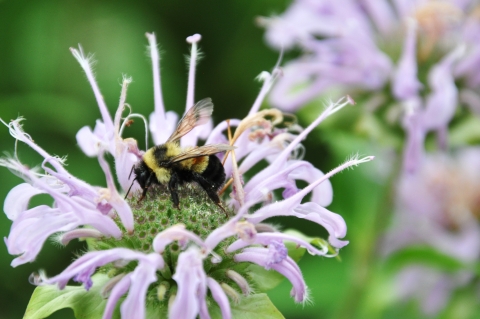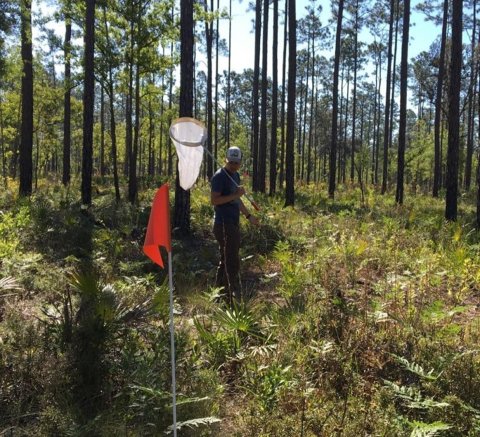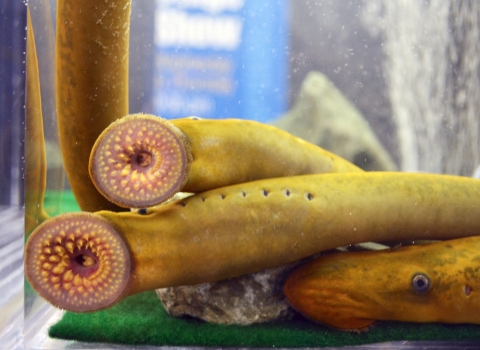It’s no secret that plant pollination is vital for human life. It’s necessary for countless other plant and animal species as well, and bees perform the majority of it worldwide. Seventy out of the top 100 human food crops — which supply about 90 percent of the world’s nutrition — are pollinated by bees. Nearly all the bee species out there don’t actually make honey for us, but they are equally important for our ecosystems and wild spaces.
“While honeybees are particularly good pollinators and important for some of our agriculture, they're not as important for our actual natural spaces,” explains U.S. Fish and Wildlife Service Conservation Biologist James Weaver.
“Since they’re important for our food supply, much of what we hear in the news on bees has to do with stresses relating to non-native honeybee colonies. What also stings is that a significant number of bees native to the U.S. are also in decline,” elaborated Weaver, who works for the Service’s Southwest Region Science Applications program. “In North America alone, there are around 4,400 unique bee species. And they run the gamut of different shapes, sizes, colors, life histories, and behaviors.”
In current classification terms, bees are of the clade Anthophila, which consists of seven distinct biological families. Among those families are over 16,000 known species, with more than a quarter of all bee species occurring in North America. Most native bee species in the U.S. are solitary pollinators. They don’t live in a hive but rather live alone in underground burrows or crevices. This makes it difficult to count how many there are, since surveyors can’t simply track down colonies.
While there are plants that can be pollinated by a variety of different animals, many plants are very specific on how they can be pollinated. This is also true for bees and other pollinators. Some are generalists, like European honeybees, and may use pollen and nectar resources from a variety of different plants, but many species of bee rely on a small handful of plants. With these delicate mutualistic relationships, it’s easy to imagine how vulnerable certain species of bees and plants are to extinction or extirpation.
One major buzzkill for native bees includes habitat loss and fragmentation. Some bee species will only travel a few hundred feet from their home burrow and need certain plants to survive. New and emerging risks including disease, pesticides and invasive plants are on the rise, all while the effects of climate change climate change
Climate change includes both global warming driven by human-induced emissions of greenhouse gases and the resulting large-scale shifts in weather patterns. Though there have been previous periods of climatic change, since the mid-20th century humans have had an unprecedented impact on Earth's climate system and caused change on a global scale.
Learn more about climate change stress and alter ecosystems more each year. The pressure is on conservationists to keep these species from going extinct.
To recover any imperiled species, knowing their abundance and distribution is important for assessing their risk level and if their native range has shifted or shrunk. This way conservation resources can be allocated where they’re needed most. As previously stated, for most bees you can’t just follow them home to find a colony with thousands of individuals. It takes a large community of both professional and citizen scientists to gather the data needed to identify conservation needs. Once the data points are gathered, either by government, non-government organizations, academic or citizen scientist programs, it’s difficult to get them all together in order to gain the widest context possible.
Luckily, there's an app for that: TheBeeTool.com
For the uninitiated, if you see a bee or other species you can use the iNaturalist app on your smartphone to identify it and report the sighting; this creates a data point, contributing to Science! That way, everyone else who wants to know about that species and where it occurs can benefit from your entry. A single data point isn’t a giant insight, but a swarm of them gives conservation pros more knowledge on the distribution of a species so they can better focus their conservation efforts.
However, not everyone reports their sightings on iNaturalist. Some folks might have just written them down. Some use databases that are for government or academic institutions. TheBeeTool.com combines a bunch of available datasets into a user-friendly visual map app. Users can quickly see how bee sightings have evolved over time.
“Look for Bombus affinis, the rusty patched bumblebee. The historic range was much of the entire Northeastern U.S.,” said James Weaver, explaining a pattern users can find with this app that he built and maintains. “Now restrict the dates from 1980 onwards and see what happens.” The range of data points quickly shrinks. This bee that was once plentiful from Atlanta, Georgia to Toronto, Canada, is now mainly reported in the greater Chicago to Minneapolis areas. This visual presentation of so many data points provides insights to conservationists and bee enthusiasts, allowing them to untangle entomological mysteries.
Many conservation professionals are already using it, and finding practical solutions that didn’t exist before The Bee Tool.
I had queried a couple different databases - but both systems identified only around 350 species in my region,” said Elizabeth Crisfield, who helps manage a habitat improvement project for state agencies in the northeastern U.S. “I knew there were at least 500 species in the mid-Atlantic alone. I was so frustrated that neither of these official tools could help me understand my project’s dataset in a regional context. When I ran the same query in The Bee Tool and found over 700 species observed historically! It was a huge relief to finally have a decent species list for the region.”
The best part of The Bee Tool is that it’s free to use: for everyone. Weaver’s creation is constantly being updated as more people add data points to the existing databases that feed The Bee Tool. However, he knows there plenty of yet-to-be incorporated data pockets out there.
“I’m a good example of this. I collected a lot of bee data while I was in graduate school, but I never published or shared those datasets,” said Weaver. “I have now entered my research data into The Bee Tool. That’s data from very rural parts of the U.S. where there aren’t many people observing bees. That’s the kind of data we need.”
Weaver encourages anyone with research-grade bee data points to send him whatever they have. That way, everyone (especially the bees) might benefit from their hard work.
“As long as those observations are adequately identified to species and contain GPS location data and date information, I can incorporate those observations into the Bee Tool almost immediately.”
If you happen to have some data sets hiding away, James would appreciate, and the bees would as well. Everyone’s data is valuable. Non-scientists can download the iNaturalist app to report bees and other species encountered in the wild.
Send your research-grade datasets to james_weaver@fws.gov.










